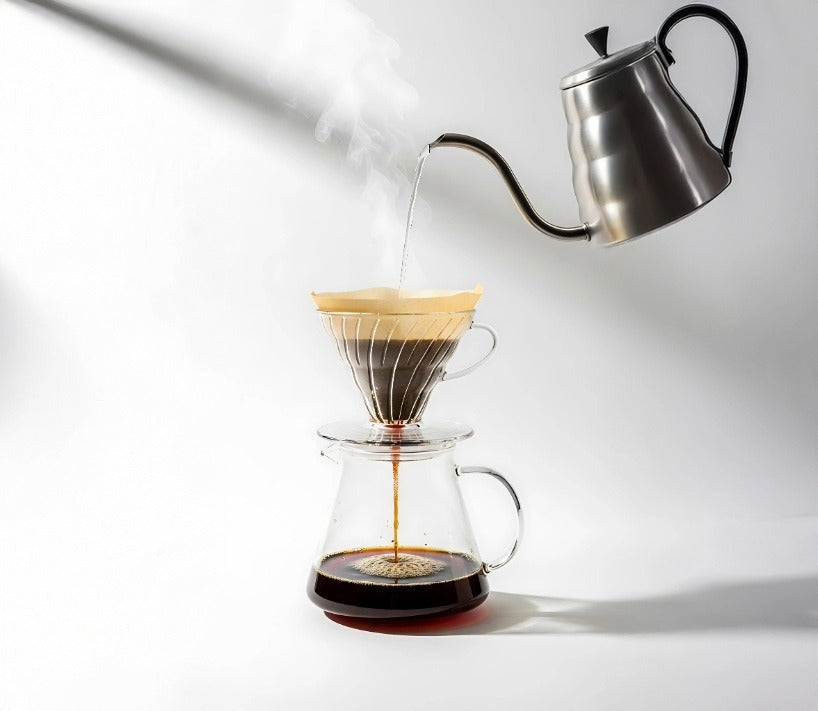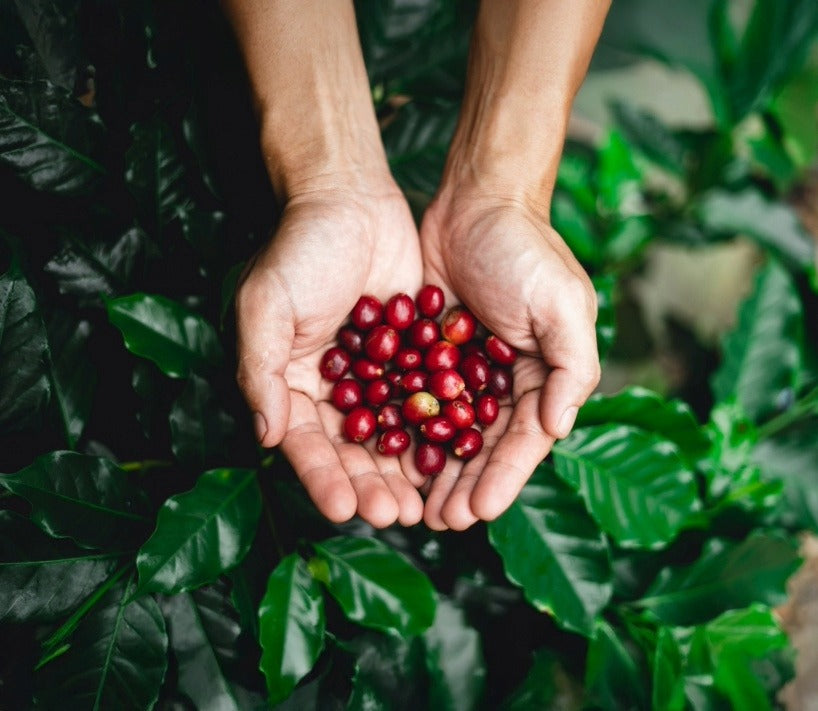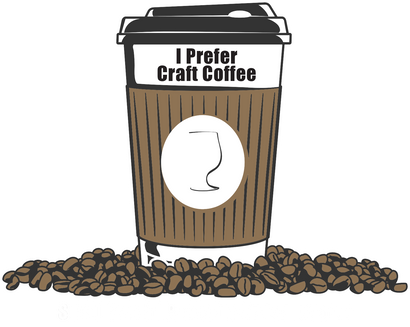Best Coffee Roasters Near Me: How I Roasted Coffee in My Kitchen
August 28, 2025 7 min read
Best Coffee Roasters Near Me: How I Roasted Coffee in My Kitchen (and Didn’t Burn the House Down)
Once upon a very brave Tuesday, I looked at a bag of green coffee beans and said, “Hi. I’m going to cook you… in my kitchen… with science.” My dog blinked twice like, “bro, no,” and my smoke detector cleared its throat.
But guess what? I roasted coffee at home and the house still exists. And that goofy first roast turned into my whole journey—from a hacked Ronco Showtime Rotisserie Oven (yep, the “set it and forget it” legend) to a 10-lb BBQ drum roaster, all the way to a clean, commercial fluid-bed air roaster. Along the way I learned the real difference between “press button, hope for magic” and “listen, smell, watch, and drop the beans when they sing.”
If you’re searching “Best Coffee Roasters Near Me,” I want to show you something close by: your own curiosity, your own kitchen, and a story that proves great roasting isn’t only about fancy software—it’s also about art, practice, and clean heat. This is a fun, true tale with real tips so you can spot roasters (and coffees) you’ll love—whether you roast at home or you order coffee online from a small, careful shop.
How It Started: The Ronco Rocket (2018)
Picture me in the kitchen with an old-school Ronco Showtime Rotisserie Oven I modded into a tiny electric drum roaster. Did it look like a spaceship built by a raccoon? Absolutely. But it spun beans, held heat, and gave me my first “popcorn popper… but for coffee” moment.
Here’s the wild part: I didn’t know how to roast yet. I learned the traditional way—ears, nose, eyes, and feel—not just a screen telling me “now do this.” I listened for first crack, watched color shift from green to yellow to brown, sniffed for hay → bread → caramel, and logged temps like a science kid who really loves snack time. I roasted, I failed, I tried again—hundreds of hours of reading and videos and “oops.” (Proud of those oops.)
Old-school lesson: roasting is art + attention. You don’t drop beans because a timer says so; you drop them when they smell right, look right, and sound right.
Leveling Up: The 10-lb BBQ Drum (Propane Era)
Next, I built a bigger drum roaster from a BBQ grill with a 10-lb drum, heated by propane. Bigger batch = bigger brain. I learned heat management, airflow, and consistency. I dialed charge temps, set turning points, and learned that small changes early change big flavors later. More variables, more control, more “ohhhh.”
But something bugged me: with gas + drum, you’re roasting in a space that involves combustion and smoke. Even with good ventilation, I didn’t want combustion byproducts anywhere near the beans. I wanted the cup to shout origin flavors, not campfire breath. So I kept looking…
Why I Chose a Fluid-Bed Air Roaster (Clean Heat FTW)
I finally landed on a fluid-bed air roaster: hot, clean air suspends beans in a floaty dance party, roasting them evenly while blowing away chaff and reducing smoke contact. Many air roasters keep the chamber cleaner and move exhaust out efficiently, which can mean a cleaner-tasting cup where origin flavors pop (think fruit, florals, cocoa) rather than smoke or scorched chaff. Ember Coffee Co.The Doghouse CoffeeKribi Coffee Air Roastery
That combo—clean hot air + high-quality, specialty-grade coffee—became my happy place. And yes, “specialty” has a real backbone: it commonly refers to coffees that score 80+ points on the SCA 100-point scale, graded by trained tasters. (Many of my educational posts use 85+ as a strong signal you’re shopping smart for the top specialty coffee online experience.) Specialty Coffee AssociationPerfect Daily GrindWikipedia
Freshness Matters (Roast Date > Best-By)
Fresh coffee is a fresh food. I learned early that a roast date matters way more than a vague “best by.” A clear roast date helps you aim for the sweet spot: flavors usually sing brightest in the first few weeks, depending on roast level and storage. (I’ve written about this a lot—linking a couple pieces below.) I Prefer Craft Coffee+1
Below is your simple playbook—part story, part guide—to help you judge roasts and roasters, whether you’re DIYing or hunting the best craft coffee at home.
The “Listen–Look–Smell–Drop” Method (A Tiny How-To)
-
Listen: First crack (tiny rice-krispie pops) = beans releasing steam and CO₂ as structures change.
-
Look: Color shifts tell you how far you’ve gone—light (tan), medium (milk chocolate), dark (dark chocolate).
-
Smell: Hay → bread → caramel → chocolate → roasty. Your nose is a tiny roast meter.
-
Drop: Don’t just chase a number; drop when the flavor goal meets the sensory cues you’ve been tracking.
Roast Style Quick Picks
-
Light: brighter acidity, fruit/floral, tea-like clarity.
-
Medium (balanced): caramel, chocolate, nutty comfort; crowd-pleaser.
-
Dark: bigger body, roasty, smoky chocolate.
When you order coffee online, read the page like a detective: roast level, process (washed/natural/honey/anaerobic), origin, variety, altitude, and—please—roast date. That’s how you find the freshest craft coffee online without guessing.
My Roaster Journey (Comparison Table)
| Roaster Stage | Heat Source | Batch Size | Smoke/Chaff Handling | Flavor Clarity | Learning Curve | Notes |
|---|---|---|---|---|---|---|
| Ronco Rotisserie Hack | Electric (radiant) | ~0.5–1 lb | Minimal control; DIY chaff catch | Decent for starters | Medium (lots of tinkering) | Great for learning sensory cues without big risk |
| 10-lb BBQ Drum | Propane (drum) | Up to ~10 lb | More smoke; chaff rides along if not managed | Good, but watch for roast smoke | Higher (more variables) | Teaches heat/airflow timing at scale |
| Fluid-Bed Commercial | Clean hot air (electric) | Pro-size | Blows chaff away, reduces smoke contact | High—origin notes pop | Pro (but consistent) | Clean chamber + even heat can = cleaner cup Home BaristaHigh Grounds |
Why this matters: in air roasting, fast-moving hot air levitates beans and helps remove chaff, which can reduce bitter, ashy flavors that happen when chaff or smoke lingers. That often delivers clearer origin character. Ember Coffee Co.Kribi Coffee Air Roastery
If You’re Shopping Roasters or Roasts (Near You or Online)
Whether you’re Googling Best Coffee Roasters Near Me or clicking around best coffee online free shipping pages, use this checklist:
Quality: Specialty-grade signals (80+ SCA; many roasters feature 85+ for “excellent”) and honest flavor notes. Perfect Daily GrindWikipedia
Freshness: Real roast date shown (not just best-by). Fast ship schedule. I Prefer Craft Coffee
Process explained: Washed = cleaner/bright; Natural = fruit-forward; Honey = sweet/balanced; Anaerobic = wild/tropical.
Roast lane fits you: Light for sparkle, Medium for dessert-y comfort, Dark for bold mugs.
Transparency: Origin, variety, altitude—say it out loud.
Conversation: Real humans answer questions (chat, email, DM). That’s how you find the top specialty coffee online that actually fits your mouth, not someone else’s.
A Solopreneur’s Little Note
I built all this with my own two hands (and a few singed eyebrows). When you support a small boutique roasting company, you support a solopreneur who wants you to enjoy the cup as much as he loves crafting it. No algorithms roasting your beans—just a human listening for first crack and saying, “Yep, that’s the moment.”
Related Reading (Backlinks to our most-read guides)
-
Best Coffee To Buy Online: Roast Date vs. “Best By” (why it matters) I Prefer Craft Coffee
-
Best Coffee Bean Delivery: Education & Buying Smart I Prefer Craft Coffee+1
-
Best Craft Coffee at Home: Why High-Scoring Air-Roasted Beans Shine I Prefer Craft Coffee
-
Best Pods for Single-Serve Brewers (Air-Roasting 101 call-out) I Prefer Craft Coffee
-
How Important Is the Roast Date on Top Coffee Delivered? I Prefer Craft Coffee
(These support your hunt for the best craft coffee at home, whether you’re browsing nearby roasters or you order coffee online.)
Quick FAQ (Human-Read Answers)
Q: Is home coffee roasting safe?
A: Yes—with caution. Use proper ventilation, monitor temps, and never leave the roaster unattended. Start small, keep a fire extinguisher nearby, and respect hot metal + hot air like a dragon who pays taxes.
Q: What’s “first crack”?
A: It’s the moment beans audibly pop like tiny rice-krispies—water and CO₂ escape, and structure changes. It’s a key sensory marker that helps you decide how light or medium to go.
Q: Why do some roasters prefer fluid-bed (air) roasting?
A: Air roasters suspend beans on hot air, remove chaff, and reduce smoke contact, which can mean cleaner flavor clarity and even development. Ember Coffee Co.Kribi Coffee Air Roastery
Q: How do I spot a good roaster near me?
A: Look for roast dates, transparent info (origin/variety/process), sensible flavor notes, and a clear roast style. If the website speaks human and invites questions, you’ve found a keeper.
Q: What about “specialty” or scores like 85+?
A: “Specialty coffee” generally means 80+ on the SCA scale; many shoppers chase 85+ as a signal for higher quality. Taste is personal, but those numbers help you filter. Perfect Daily GrindWikipedia
Tiny Taste Map (So You Aim On Purpose)
-
Love bright fruit & tea? Try light roasts, often washed or delicate naturals.
-
Want dessert-y comfort? Try balanced medium roasts (honey or washed) for caramel/chocolate.
-
Like bold & toasty? Try medium-dark washed for classic “coffee-coffee.”
If a bag says “best coffee bean delivery” or “best coffee to buy online,” peek at the roast date and process. Those two clues help you pick winners fast—and they’re how you get the freshest craft coffee online without detective goggles. I Prefer Craft Coffee
The “Best Coffee Roasters Near Me” Checklist (60 Seconds)
-
Roast date shown (recent)
-
Roast style matches you (light / medium / dark)
-
Process fits your flavor goal (washed/natural/honey/anaerobic)
-
Transparent details (origin, variety, altitude)
-
Realistic notes (cocoa, almond, cherry—not a whole perfume commercial)
-
Human help available (ask a question, get a real answer)
Use it for local shops and when you order coffee online from top specialty coffee online sources (bonus: some offer “best coffee online free shipping” promos—just make sure freshness, not freebies, decides your cup).
PS
I’m the same kid-at-heart who roasted coffee with a Ronco and a dream. Then a BBQ drum. Then a fluid-bed that keeps heat clean and flavors clear. When you cheer on a small roaster, you’re cheering on the craft—the listening, smelling, watching, and the “drop now!” moment that turns beans into mornings you actually look forward to.
Also in Best Coffee To Buy Online Education

Biggest Mistake With Pourover Coffee: It's Your Beans
January 02, 2026 3 min read
Learn how to brew the best pourover coffee at home with the best tasting craft coffee online. Remember, the best coffee to drink at home starts with the freshest craft coffee online, not the bargain bin beans at your local supermarket.

Specialty Roast Coffee Beans Online: What’s the Deal, Really?
January 01, 2026 4 min read
You'll learn what specialty roast coffee beans online actually means, and why it translates to the best tasting craft coffee at home.

High-Score Coffee Beans Online: Why 85+ Points Actually Matter
December 31, 2025 3 min read
Learn why the best tasting craft coffee online is high-scoring specialty coffee that tastes better and how to choose the right beans online. Order coffee online from a roaster you trust.
